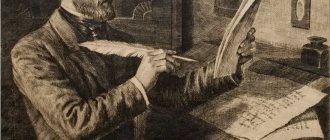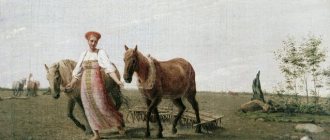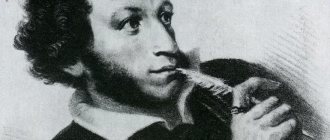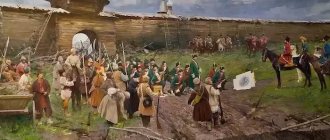- Essays
- On literature
- Pushkin
- Analysis of Belkin Pushkin's Stories
Select works for analysis:
Shot
Blizzard
Undertaker
Stationmaster
Peasant young lady
In the autumn of 1830, Alexander Pushkin had to stay in Boldino, because due to the fact that the disease was raging at that time, he could not travel beyond the place where he was. However, despite some limitations in free movement, the author was inspired by this magnificent time of year, and as he himself admitted, the rural autumn setting helps to better concentrate on business and inspires the creation of new wonderful works. This period, which lasted about three months, turned out to be very favorable for the writer. After all, he managed to finish several quite important works, as well as his collection of stories called “Belkin’s Tales”. It was a truly unique creation, in which the author tried to reveal the images of various people who, at first glance, may seem quite ordinary people. And yet, the situations in which the heroes of these works find themselves are very interesting and vivid.
For these stories, the author used materials related to his memories, as well as all the most interesting stories that both he and his comrades knew. For the title of the collection of these works, the author chose the surname of a non-existent person, and created his image in the likeness of a person who is a landowner. Thanks to such a reasonable decision, the author had no problems with both critics and censors. These works contain big and small problems of ordinary people who have dreams, goals and plans that will help them become happy. This life of the heroes is shown to be simple, and at the same time interesting, it is far from romanticism, and this is not at all surprising, because the author wanted to create a realistic work.
Despite the small volume of some works, the writer revealed the main problems relating to “little people”. Here Pushkin abandons the strict and definite division of characters into good and bad, and shows that in many, several sides of the personality coexist simultaneously, which manifest themselves under various kinds of circumstances. He wanted to show that despite all the hardships of the heroes’ lives, they often came to the conclusion that it was still necessary to live according to their conscience and not commit evil and other bad deeds. All stories have a fairly similar and interesting structure, but at the same time they have different ideological and plot parts.
Belkin's stories - artistic analysis
“Belkin's Tales” (1830) includes five works: “Shot”, “Blizzard”, “Undertaker”, “Station Warden”, “Peasant Young Lady”.
Adjacent to them is “The History of the Village of Goryukhin”. The stories widely cover Pushkin's contemporary reality. They give pictures of social relations and life and the local nobility (“Blizzard”, “The Young Lady-Peasant”), and army officers (“Shot”), and city artisans (“Undertaker”), and petty officials (“Station Warden”) , and the serf peasantry (“History of the village of Goryukhin”).
Pushkin published the story anonymously, attributing the authorship to a fictitious person - Ivan Petrovich Belkin.
The most significant story is “The Station Agent”. The truth of life, the warm, sympathetic attitude of the author towards the “little man”, a petty official, insulted at every step by people of higher rank and social status - this is what we find when reading the story.
note
Telling the tragic story of a stationmaster, from whom the hussar Minsky took away the old man’s dearly beloved daughter, the only joy in his difficult life, Pushkin reveals the injustice of social relations that developed under the autocratic-serf system.
Here a person is assessed according to his position in society; lack of rights and constant humiliation of human dignity is the fate of the poor and unofficial.
With caustic mockery, Pushkin points out the ingrained nature of such orders in landowner-bureaucratic Rus': “In fact,” he writes, “what would happen to us if instead of the generally convenient rule: honor rank, something else was put into use, for example: mind of mind read it? What kind of disputes would arise, and who would the servants start serving food from?”
This story is imbued with democracy and humanity, so realistically
depicting the life and spiritual world of ordinary people. “Simply, briefly and clearly,” in the words of Pushkin, this story is written. The story “The Station Warden,” with its focus, attention and sympathy for the “little man,” had a strong influence on subsequent Russian prose, and above all on Gogol’s “The Overcoat.”
“The History of the Village of Goryukhin” is a sharp political satire on serfdom, despite the fact that at first glance it seems so naive and ingenuous. Consider, for example, the chronicle kept by great-grandfather Yves. P. Belkina: “May 4th. Snow. Trishka for roughness. 6 – the brown cow died. Senka beats me for drunkenness... 9 – rain and snow.
Trishka bit according to the weather.” The clerk’s reign was even worse: “In three years, Goryukhino became completely impoverished. Goryukhino became despondent, the bazaar was deserted, Arkhip Lysy’s songs fell silent, the children went around the world.”
From “The History of the Village of Goryukhin” a direct path leads to “The History of One City” by the great satirist Saltykov-Shchedrin and to the works of Nekrasov (“Who Lives Well in Rus'”, etc.).
Source: https://rus-lit.com/povesti-belkina-xudozhestvennyj-analiz/
Afterword
Alexander Sergeevich Pushkin projected the future of Russia at the level of the second semantic series of his works, and, as we have seen, analyzing the Boldino period of his work, he was able to protect the matrix of the transition to this future with allegory. Pushkin's work is clear, bright, perfect and mysterious. Therefore, not everyone can read and understand Pushkin, solve his riddles. S.A. Yesenin said:
“To comprehend Pushkin - you already need to have talent”
Pushkin is immortal. He lives in the spirit of the people and will soon reveal himself, as N.V. predicted. Gogol:
“Pushkin is an extraordinary phenomenon and, perhaps, the only manifestation of the Russian spirit: this is the Russian man in his development, in which he may appear in two hundred years.”
A. S. Pushkin
Education February 2, 2018
In September 1830, Pushkin arrived at his father’s estate in Boldino. Here he finished the last chapters of Onegin, wrote several scenes and tragedies, about thirty poems and “5 stories in prose,” which he reported in a letter to Pletnev.
Pushkin wrote “Belkin’s Tales” (his first creation in prose) with pleasure and enthusiasm, “feeling joy from inspiration.” The stories created in September-October showed the maturity of talent, strength and inner freedom of the writer. This quality of his works was immediately noted by his contemporaries.
Pushkin wrote that Baratynsky “neighed and fought” while reading them, and Kuchelbecker admitted that he laughed “from the good heart” and would like their author to know that his works “dispelled the blues of his unfortunate friend.”
"Five Stories"
Even not the most in-depth analysis of “Belkin’s Tales” will allow us to notice that the author, with a smile and good humor, spoke about post-Decembrist Russia and ordinary people, their hopes, disappointments, suffering, everyday minor tragedies and comic adventures.
Pushkin refused authorship and handed it over to Ivan Petrovich Belkin, a retired officer, a meek, kind young man. Interested in fine literature in his spare time, Belkin collected these “simple” stories from various storytellers and processed them at his own discretion.
Thus, the real author of these stories is hidden behind a double chain of narrators, which gives him freedom of narration, the opportunity for satire and parody, and allows him to express his attitude towards them.
Important
A complete analysis of Belkin's Tales shows that the stories included in the cycle are very entertaining. But not all of them are funny. The Belkin cycle includes five works. They are all different types, none of these stories is similar to the other. Some of these stories are serious and sad.
Thus, “The Station Agent” is a serious and somewhat sad story, “The Blizzard” and “The Peasant Young Lady” are partly humorous, “The Undertaker” also contains irony, affecting typical Russian reality, and “The Shot” is a romantic short story with a sharp plot and an unexpected ending.
Let's talk about these stories in more detail.
"Shot"
Judging by the date October 14, 1830, indicated by the author, this story was written as one of the last in the “Belkin’s Tale” cycle. We begin our analysis of “The Shot” with the plot and compositional features of the work.
Initially, the work consisted of one chapter and contained the life impressions of the author himself, right down to autobiographical realities (Pushkin’s duel with officer Zubov). The epigraph of the story “Shot” refers the reader to Marlinsky’s work “Shot at the Bivouac,” which contains the motif of a “delayed shot.”
Having finished the work on October 12, the author wrote that the ending was lost. Only 2 days later Pushkin added a second chapter, compositionally repeating the first. Both chapters are structured according to the “mystery novella” principle.
In the first of them, the main character Silvio keeps a secret. In the second chapter, the author introduces new characters - the count and his wife, but the reader is waiting for the solution to the mystery and is left with the feeling that there is some kind of connection between completely different people - the count and Silvio.
The secret is revealed in the Count's interpolated story. Thus, the short story turns out to be compositionally complex: two different episodes, and inside each there is an additional story. At the same time, the second prehistory continues the first.
This construction of the work expands the time boundaries and creates plot tension. Further analysis of “Belkin’s Tales” shows that the masterly construction of the story “The Shot” revealed the appearance of the main character from different sides.
Despite the fact that there are few characters, the work seems “densely populated” because it depicts different social worlds.
Video on the topic
"Blizzard"
The next work of "Belkin's Tales", the analysis of which we will begin with plot and compositional features, is the story "Blizzard". The plot is based on a curious incident - the unexpected marriage of a young military man to a provincial girl.
Blizzard
The Blizzard is one of three stories told by the girl K.I.T. The daughter of the landowner R., Marya Gavrilovna, was in love with the army ensign Vladimir Nikolaevich. They corresponded, met in the forest, and Vladimir Nikolaevich persuaded Marya Gavrilovna to run away with him. He even conspired with the priest to marry them secretly.
That day there was a strong snowstorm. Marya Gavrilovna arrived at the church, and Vladimir Nikolaevich got lost, as if he was being led by evil spirits across the field. He arrived at the church only in the morning.
That same morning, Marya Gavrilovna came to the table as usual, but by nightfall she fell ill. No one ever found out that the young lady was not at home at night. Marya Gavrilovna burned the letters to her parents, all the conspirators kept their tongues shut, but in her delirium, the girl often called the name of Vladimir Nikolaevich. And then the father, who had hitherto refused the poor landowner, decided to agree to the marriage. But Vladimir Nikolaevich wrote a half-crazy letter, from which the parents of the sick girl did not understand anything, and soon they learned that the groom had gone to war. It was 1812.
Vladimir Nikolaevich died in the war, and Gavrila Gavrilovich also died. Marya Gavrilovna remained the heir to all the estates and took care of her mother.
Heroes were returning from the war, and where the military appeared, the civilians had to humbly retreat. Marya Gavrilovna also had such a fan. They fell in love with each other, but...
One fine day, Burmin admitted to Marya Gavrilovna that he was married, but he didn’t remember who or where he had married. By a lucky coincidence, it turned out to be Marya Gavrilovna herself. When Vladimir Nikolaevich got lost in bad weather at night, Burmin drove into the church. He was amused by the current situation; he did not reassure anyone that he was not the one they were waiting for. He was married, and when the priest invited the husband and wife to kiss, Marya Gavrilovna saw that it was a different person. Burmin then ran away from the church, and Marya Gavrilovna returned home. (“Blizzard”: full text)
A. S. Pushkin. "Belkin's Tales". Analysis of the work
ActionTeaser.ru - teaser advertising
Time of creation
"Belkin's Tales" is Pushkin's first completed prose work. All the stories were written in the village of Bolshoye Boldino in the fall of 1830. According to the author’s dating, the stories were completed: “The Undertaker” - September 9; “The Station Agent” - September 14; “The Young Lady-Peasant” - September 20; “Shot” – October 14; "Blizzard" - October 20.
The preface “From the Publisher” dates from the second half of October or October 31 - early November 1830.
Plot and characters
The narration is told on behalf of the good-natured, poor landowner Belkin, a fictitious person. This gives the story an impression of complete authenticity. Belkin reports that he heard all the cases from different people. But through the images of the narrators, especially in epigraphs, remarks and digressions, the voice of Pushkin himself can be felt.
The main character of the story “The Shot”, Silvio, is a strong and brave man with a solid, passionate character and an exotic non-Russian name, reminiscent of the mysterious and fatal heroes of the romantic poems of Byron and the young Pushkin.
He has to serve in an army regiment in a boring province, drink, play cards with not very educated officers. There is a secret in Silvio's life.
Undertaker
This Gothic story was told to Belkin by clerk B.V.
Coffin master Adrian Prokhorov bought himself a house on Nikitskaya Street, which was more spacious than his former home. A neighbor, a German, came to him and invited him to a silver wedding. The undertaker accepted the invitation. The next day he and his family went on a visit.
When everyone had drunk a fair amount, everyone was in a cheerful mood, one of the guests, a baker, suggested a drink “To the health of those for whom we work.” Only the poor undertaker could not drink “to the health of his dead.” Therefore, the remark of the guard Yurko seemed offensive and offensive to him. Returning home, he promised to invite not his neighbors to the housewarming party, but his dead. Dead drunk himself, he fell asleep.
But at night he was woken up with the news that the merchant Tryukhin had died. Having finished his business and returning home, he saw that people whom he had once buried were walking around his rooms. Among the guests was retired sergeant Kurilkin, to whom the undertaker sold his very first coffin, passing off a pine coffin as an oak one. Out of fear, Adrian pushed away Kurilkin's skeleton, which fell and crumbled. There was a murmur among the dead. Adrian himself fainted right on the bones of the retired sergeant.
The next morning, waking up in a sunlit room and seeing his wife and daughters busy in the kitchen, the undertaker realized that everything he saw was just a dream. It immediately became clear that Tryukhina was alive and well, and had no plans to die.





